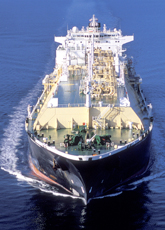The international energy Environment
>
Oil
>
Price developments
Price developments
In mid-January 2007, oil was priced at 51 dollars a barrel (the lowest level for 20 months), and finished the year at over 95 dollars.
January.
Saudi Arabia refuses to make a further cutback in production.
Oil began the year at 51 dollars a barrel in mid-January (the lowest level for 20 months), following the refusal of Saudi Arabia to make a further cutback in production quotas, as other OPEC members had requested. Prices began to rise, to over 60 dollars/barrel by the middle of March. The incident between the British and Iranian navies in mid-March pushed crude up to about 70 dollars. Values around this figure continued into April.
April.
Tensions between the IEA and the cartel.
In its April report, the IEA voiced its concern over the supply of crude and urged the cartel to increase production. OPEC had reduced its daily pumping rate by 165,000 barrels. Any source of tension in the producing areas or a decline in stocks in the USA gave a boost to the spot prices. In May, for example, the price declined until the end of the month, when tension increased over Iran’s nuclear activities and the incidents in Nigeria. Nervousness caused the crude price to climb to over 70 dollars at the end of July.
PRICE OF CRUDE. SPOT. FOB MARKET
AVERAGE VALUES ($/barrel)
Crude
- Dubai
- Brent
- Wti
API
- 32
- 38
- 40
1982
- 30,88
- 32,86
- 33,68
2002
- 23,55
- 25,02
- 26,16
2003
- 26,76
- 28,83
- 31,06
2004
- 33,69
- 38,27
- 41,49
2005
- 49,54
- 54,52
- 56,59
2006
- 61,52
- 65,14
- 66,02
January
- 51,69
- 53,68
- 54,14
April
- 63,97
- 67,51
- 63,85
2007
July
- 69,49
- 77,01
- 74,19
Oct.
- 77,12
- 82,50
- 85,92
Dec.
- 85,98
- 90,97
- 91,55
Source: Energy Prices and Taxes. AIE. OECD
At about that time, the International Energy Agency published a new report which reflected the concern over growing demand in China and other emerging countries. The increase in supply would not be sufficient due to delays in some projects in Iran, Iraq and Venezuela. This could get worse in 2012, when surplus production capacity will be dangerously reduced.
Another aspect of the medium-term situation was presented by the US Department of Energy, whose annual report predicted a decline in crude demand across the world from 2015, due to its high price.
Another aspect of the medium-term situation was presented by the US Department of Energy, whose annual report predicted a decline in crude demand across the world from 2015, due to its high price.
July – September.
Increased price volatility and international tensions.
The fact is that by the end of July, all the main players in this market (including OPEC) were nervous. The high price volatility combined with fears over the impact of high prices on the economy. OPEC even stated in September that it was not in control of the market or the crude prices. Political conflict, financial speculation and refining problems were more important than the crude market itself. This fear finally forced a nominal production increase in the OPEC countries, which, at their 145th ministerial conference, in September, decided to increase it by 500,000 barrels a day from 1 November. However, the agreement did not stop Texas crude (WTI) breaking the 80 dollars/barrel barrier for the first time in history.
At this time, a clear correlation was evident between the rise in crude and the fall in the dollar’s value against the euro. We were also seeing an effort by the OPEC members to maintain their income in real terms.
At this time, a clear correlation was evident between the rise in crude and the fall in the dollar’s value against the euro. We were also seeing an effort by the OPEC members to maintain their income in real terms.
At the end of October, the WTI shot up to 92 dollars/barrel. It was the start of a surge which took it close to 100 dollars/barrel in the first half of November.
December.
OPEC defers the possible production increase.
The 146th OPEC ministerial conference in early December decided to defer the possible production increase until at least February. OPEC’s joint quota had been set at 27.25 million barrels a day since 1 November 2007. The entry of Ecuador and Angola has raised the joint quota to 29.65 million. Despite some falls during the rest of the year, 2007 ended with prices above 95 dollars.
January 2008.
The USA responds with new prospections
At the end of this process, by mid-January 2008 the symptoms of a probable economic crisis were clear. Crude fell from 90 dollars. The cartel summit in February decided not to increase its members’ production. At the same time, the USA decided to start exploration in the Chukchi Sea, to the northwest of Alaska, an option regarded with misgivings because of its environmental value. The world’s largest oil and natural gas consumer wanted to ensure that its quota of external dependence would not increase dangerously during the next few decades.
The Gulf of Mexico resource (together with the China Sea and North Sea, one of the areas expected to receive half of the offshore platforms between now and 2012) is important in the medium term, but insufficient in the long term.
The Gulf of Mexico resource (together with the China Sea and North Sea, one of the areas expected to receive half of the offshore platforms between now and 2012) is important in the medium term, but insufficient in the long term.
Annual
Report
07
-
 BP
BP -
 Reganosa
Reganosa
Annual Report 2.007: Sedigas - The Spanish Gas Association

